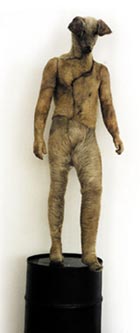|
"From the family" by Ljubomir Miloseski in Stip
|
|
On 08.04. 2004. in the city
of culture for 2004, Stip, the socially provocative
exhibition "From the family" by Ljubomir Miloseski, young
artist from Struga, will be opened.
|
 The
ehxibition is part of the project "Confluent Margins" of the NGO
"Kontrapunkt" and is cooperation with the National theatre of Shtip.
The exhibition will be held in the hall and the buffet of the
theatre and will be opened before and after the first stage of the
play "Trip around my father of the theatre. The sculptures of
Miloseski with their motives (leader, family, community) touches the
political and get additional connotations posed in the "city of the
presidents". This exhibition, after Shtip, will also be held in
Tetovo. The
ehxibition is part of the project "Confluent Margins" of the NGO
"Kontrapunkt" and is cooperation with the National theatre of Shtip.
The exhibition will be held in the hall and the buffet of the
theatre and will be opened before and after the first stage of the
play "Trip around my father of the theatre. The sculptures of
Miloseski with their motives (leader, family, community) touches the
political and get additional connotations posed in the "city of the
presidents". This exhibition, after Shtip, will also be held in
Tetovo.
Ljubomir Miloseski
Born 1974 in Struga, Republic of Macedonia. 1999 graduated at the
Faculty of Fine Arts in Skopje, pedagogic department - painting, in
the class of prof. Rubens Korubin. M.A. degree 2002 at the same
Faculty, painting department, in the class of prof. Rodoljub
Anastasov.
Solo exhibitions:
1999
Skopje, Museum of City of Skopje
2003 Skopje, Art Gallery "Cifte Hamam"
Struga, Cultural
Centre "Braka Miladinovci"
Participated on many exhibitions in Macedonia and abroad.
from Maja Cankulovska's review:
Analyzing Ljubomir Miloseski's work in a short text unavoidably
poses a particular challenge. The reason for that lies in this
project's complexity, which in turn offers many directions for
interpretation. The project is seemingly "easy" to interpret, but
the deeper one delves into it, the more layers one inevitably
discovers, i.e. many sets of sign structures confronting and linking
the issues of the artistic and the engaged, as well as the modern
and the contemporary.
"From the Family" (2003) is a continuation and extension of the
project "Mutations" (2002). In these two projects, Miloseski
(re)examines humanity through the relation human being/animal, i.e.
alive/dead. In the first case, he makes a forceful life-size figure
of a bull, and later on produces life-size "people"; because,
according to the author, the pain cannot be felt when it occurs to
someone else. In both cases the material he uses is cheap and
natural - pigskin; as a material of specific energy, "attraction" (a
particular odor, tactile qualities) and of symbolic impurity.
There's no blood as an expression of brutality; rather, it is
expressed by the material that has retained its "living"
characteristics.
The confrontation, as well as the overall functioning of the
project's artistic elements, stems from the figural representations
themselves: even though they're arranged as an installation, they
function as independent sculptures. The author maintains a relation
towards pure artistic elements: three-dimensionality, immobility,
drawing (the wounds, stitches on the hide), color (taking into
account the material's natural color), light/shadow, concealed
eroticism - as a reminder of modernity. The use of live or dead
animals (including animal materials and odors) as objects, subjects
or symbols in the making of artworks is not unfamiliar to art
history (Joseph Beuys, Damien Hirst, Oppenheim etc); but Ljubomir
Miloseski brings an unusual "impudence" to it by creating "the
perfect creature", the human being.
The title of the project "From the Family" refers to
linking life and art and the artist's engagement; the artist is no
longer isolated from the events around him, in this case humanity's
global problems - killing and cloning, the alienation and cruelty of
the dominant human. The engagement, i.e. the criticizing of
"humaneness" is also experienced through the interaction with the
audience, that is by facing the author's artistic position. This act
of facing the Other from the Same is usually followed by a sense of
repulsiveness. If we use Kristeva's position that repulsiveness is
close to us and we continue and paraphrase it, we might conclude
that repulsiveness is close to us because it originates from
ourselves, which can once again be defined by today's urban man's
fear of loosing sterility and comfort. The use of dead animals as
certain objects of creation reflects the author's pessimism and his
deep existential distress. Through this apocalyptic vision of
humankind we're offered, one question remains - what lies beyond,
after man? |
|
|
|

|